Beer connoisseur Brandon Sarna tells us that craft breweries offer flavors you can’t find anywhere else. Mass-produced beers are homogenized and standardized, but small breweries offer flavors that you may taste once and never find again.
But where can you find vintage beers? And could you ever create a craft beer at home?

Brandon Sarna has —- suggestions. These are the essentials for any seeker of unique flavors in beer.
Get to Know the Lingo of Craft Breweries
Where do you start defining a style of brewing? Begin with the geographic origins of the beer. You are probably familiar with these beer-loving countries.
- American beers are generally hops-forward. They often incorporate citrus, pine, and resin flavors.
- Belgian beers encompass some fruity ales and some unusually sour beers. There are also spicy Belgian beers,
- German beers often have a complex malt flavor. They are made with floral hops.
- English-style pale ales, porters, and stouts evoke images of centuries-old village pubs. Their earthy flavors make an unmistakable connection with history.
- Be aware of craft breweries specializing in the beers of Ireland, the Czech Republic, Scandinavia, Australia, the Philippines, and Japan. Beers from all over the world expand your palate.
Look for beers that age well. Over 90 percent of craft beers should be consumed immediately, but some beers age in wooden casks for a year or even more.
Don’t underestimate the importance of color in beer. Just as people eat with their eyes first they also drink with their eyes first. Seeing an amber beer prepares your palate for a crusty, toasty, bready beer. Brown beers often evoke flavors of chocolate and roasted nuts. Black beers remind you of coffee and espresso, while pale beers carry the taste of wholesome grains.
Learn the yeasts used in different ales and lagers. Seek out unusual additives such as fruit, chocolate, coffee, herbs, and spices.
Get to Know Your Local Experts in Beer, Brandon Sarna Says
There is one place you are sure to learn something new about craft brewing. It’s at your local craft breweries!
Craft brewers can usually be found close to their brew. They are your single best source of information about their beer and beer brewing in general.
Your fellow patrons at the brewery can help you broaden your horizons by steering you to new beers. Sometimes you will share their tastes. Sometimes you won’t. But they are a great way to become more knowledgeable about beer.
What About Home Brewing?
Brandon Sarna believes that every homebrew is unique. Tiny differences in water, in the mash, in yeasts added to the mash and falling from the air, and variations in brewing technique produce always-inimitable and sometimes exemplary flavors.
But don’t limit your enjoyment of beer to homebrew. Build up the craft with regular visits to the craft breweries that are constantly producing new beers.

